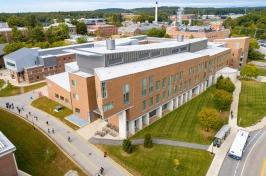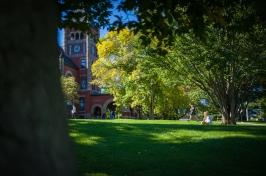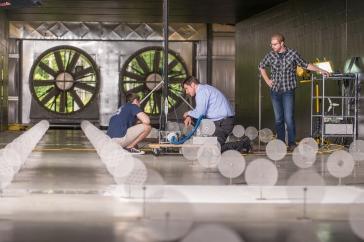Two professors from the College of Engineering and Physical Sciences (CEPS) at UNH have been awarded the esteemed National Science Foundation (NSF) Faculty Early Development (CAREER) award.
Chemistry’s Nate Oldenhuis and mechanical engineering’s Nathan Laxague were selected for the program that supports “early-career faculty who have the potential to serve as academic role models in research and education and to lead advances in the mission of their department or organizations.”
The two grants, totaling $1.4 million over five years, are expected to improve parameterizations of the interaction between atmosphere and ocean, and to develop new chemistries to make into materials.
Nate Oldenhuis

Oldenhuis ($707,830 grant) plans to further research in deoxyribonucleic acid (DNA) based materials. His research entails making large quantities of DNA using a bioreactor, developing new chemistries to make into materials, and ultimately studying those materials’ properties.
Oldenhuis’ research utilizes the same technology that produces nucleic acids for the COVID vaccine, creating gram scale amounts of DNA for non-traditional applications in a simple and cost-effective way.
“Much like how a sweater is a result of knitted threads, we use DNA’s unique ability to be moved around by proteins to understand how the orientation of ‘threads’ contributes the resulting material (sweater),” says Oldenhuis.
Oldenhuis’ research could lead to materials with “unmatched toughness and resilience.” He says it will help further our understanding of fundamental bio-physics questions, like why DNA doesn’t get tangled or torn during cell replication in the nucleus.
“I am so happy to receive such an award and would like to thank all of my connections at UNH for helping me accomplish this feat,” he says.
Nathan Laxague

Laxague’ research ($738,012 grant) plans to further understand air-sea interaction, a subdiscipline of geophysical fluid dynamics which overlaps with physical oceanography, boundary layer meteorology and ocean engineering.
The grant will allow Laxague to perform field observations of the interactions of wind, waves and currents off the New Hampshire seacoast using an instrumented air-sea flux buoy and an uncrewed aerial vehicle (UAV) with a custom-built payload.
“This region (the New Hampshire seacoast) is well-suited to our projects because of the strong diurnal (daily) oscillation in wind forcing and wave states which result from sea breeze,” says Laxague.
His goal is to improve parameterizations of the interactions between atmosphere and ocean, provide a greater understanding of the growth and development of surface waves, and “hopefully reduce uncertainties in numerical weather/wave forecasts.”
In addition, Laxague’s project will support collaboration with the Seacoast Science Center in Rye, New Hampshire, in the development of new exhibit and public engagement activities.
“This is a tremendous honor, and I’m thrilled to receive the opportunity to perform activities I proposed, with the help of my research group members," Laxague says.
-
Written By:
Hayley Barnhard | College of Engineering and Physical Sciences | hayley.barnhard@a4group.net



















































